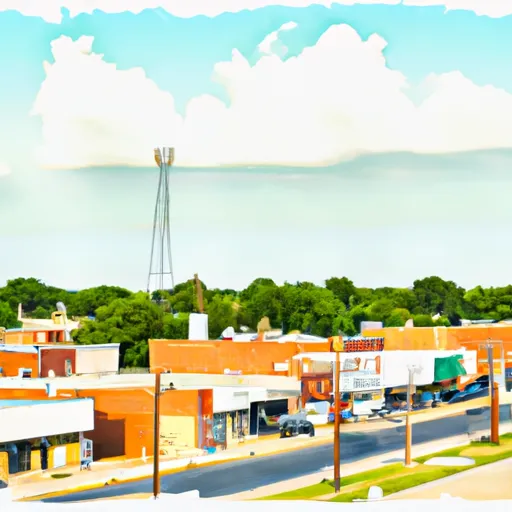-
 Snoflo Premium
Snoflo Premium
Get unlimited access to all our content
With no Ad interruptions! - Start Your Free Trial Login with existing account
Wynona
Eden Index
Climate
8.3
•
Recreation
2.6
•
Community
1.3
•
Safeguard
4.5/10

Wynona, Oklahoma is a small town located in Osage County in the northeastern part of the state. It experiences a humid subtropical climate, characterized by hot summers and mild winters. Average high temperatures range from around 90°F (32°C) in the summer to approximately 50°F (10°C) in the winter. Precipitation is evenly distributed throughout the year, with an annual average of 40 inches (102 cm), mainly in the form of rain.
The town is not situated near any major bodies of water, but it is part of the Arkansas River watershed. The hydrology constituents in Wynona primarily consist of creeks and streams that flow into the nearby Caney River. These waterways provide opportunities for fishing, canoeing, and other water-based activities.
Wynona also offers various outdoor recreation opportunities for nature enthusiasts. The surrounding area is characterized by rolling hills and wooded landscapes, providing a picturesque setting for hiking, camping, and wildlife watching. Outdoor enthusiasts can explore nearby Osage Hills State Park, which offers a range of recreational activities including fishing, boating, hiking, and horseback riding. With its pleasant climate and diverse outdoor offerings, Wynona provides a tranquil escape for those seeking a connection with nature.
What is the Eden Index?
The Snoflo Eden Index serves as a comprehensive rating system for regions, evaluating their desirability through a holistic assessment of climate health, outdoor recreation opportunities, and natural disaster risk, acknowledging the profound impact of these factors on livability and well-being.
Climate Health Indicator (CHI): 8.3
Wynona receives approximately
1054mm of rain per year,
with humidity levels near 81%
and air temperatures averaging around
16°C.
Wynona has a plant hardyness factor of
6, meaning
plants and agriculture in this region thrive during a short period during spring and early summer. Most
plants will die off during the colder winter months.
By considering the ideal temperature range, reliable water supplies, clean air, and stable seasonal rain or snowpacks, the Climate Health Indicator (CHI) underscores the significance of a healthy climate as the foundation for quality living.
A healthy climate is paramount for ensuring a high quality of life and livability in a region, fostering both physical well-being and environmental harmony. This can be characterized by ideal temperatures, reliable access to water supplies, clean air, and consistent seasonal rain or snowpacks.
Weather Forecast
Streamflow Conditions
Verdigris
Area Rivers
Verdigris
Snowpack Depths
Verdigris
Reservoir Storage Capacity
Verdigris
Groundwater Levels
Recreational Opportunity Index (ROI): 2.6
The Recreational Opportunity Index (ROI) recognizes the value of outdoor recreational options, such as parks, hiking trails, camping sites, and fishing spots, while acknowledging that climate plays a pivotal role in ensuring the comfort and consistency of these experiences.
Access to outdoor recreational opportunities, encompassing activities such as parks, hiking, camping, and fishing, is crucial for overall well-being, and the climate plays a pivotal role in enabling and enhancing these experiences, ensuring that individuals can engage in nature-based activities comfortably and consistently.
Camping Areas
| Campground | Campsites | Reservations | Toilets | Showers | Elevation |
|---|---|---|---|---|---|
| Feyodi Creek RV Park | 54 | 755 ft | |||
| Hominy Municipal Lake | None | 895 ft | |||
| Sedan City Park | 15 | 843 ft | |||
| Holdenville Lake | None | 810 ft | |||
| Wewoka Lake | None | 851 ft | |||
| Rock Ridge Cove North - Fall River Lake | 45 | 973 ft | |||
| Bluestem Lake | None | 915 ft | |||
| Osage Hills State Park | None | 785 ft | |||
| Caney Bend | 5 | 800 ft | |||
| Moline City Park | None | 1,040 ft |
Catastrophe Safeguard Index (CSI):
The Catastrophe Safeguard Index (CSI) recognizes that natural disaster risk, encompassing floods, fires, hurricanes, and tornadoes, can drastically affect safety and the overall appeal of an area.
The level of natural disaster risk in a region significantly affects safety and the overall livability, with climate change amplifying these risks by potentially increasing the frequency and intensity of events like floods, fires, hurricanes, and tornadoes, thereby posing substantial challenges to community resilience and well-being.
Community Resilience Indicator (CRI): 1.3
The Community Resilience Indicator (CRI) recognizes that education, healthcare, and socioeconomics are crucial to the well-being of a region. The CRI acknowledges the profound impact of these elements on residents' overall quality of life. By evaluating educational resources, healthcare accessibility, and economic inclusivity, the index captures the essential aspects that contribute to a thriving community, fostering resident satisfaction, equity, and social cohesion.

